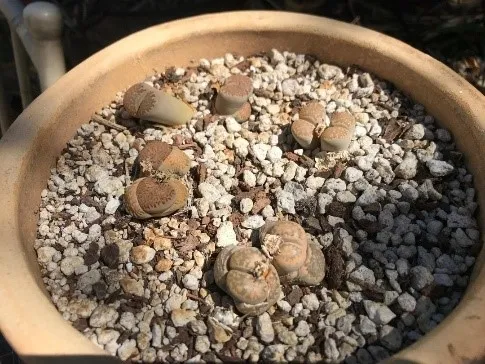While perusing the UCCE Master Gardener-Solano Facebook Page, I found a captivating photo that Master Gardener Sharon Leos posted. The photo displayed what appeared to be colorful pebbles that were surrounded by tiny rocks, placed neatly in a pot. On closer look, I noticed that the photo was titled “Lithops” and are actually a plant… really!?!?
I was not familiar with Lithops, so I contacted Sharon to get more information.
Sharon said that the Lithops (Lithops spp.) are what some folks call “living pebbles “plants and are a part of the Aizoaceae succulent family. Sharon explained that she had not seenLithops at local nurseries, but then her husband found them inBenicia. She purchased severalLithops and said that they doing well, some even flowered this year. However, she did say that some have mysteriously disappeared, a treat for birds or squirrels?

There is always something new to trigger curiosity and discovery. So, I did some quick research and learned that these charming succulents are native to dry, rocky areas in Africa. However, they appear to do well in other dry climates like in our local Solano County zone. They can also make lovely indoor plants.
Lithops are small and range between ½ - 1½ inches in size. These plants have many common names reflecting their appearance, such as flowering stones, pebble plants, living pebbles, and living stones… hence the reason they are called Lithops, (Greek term for stone-like).
Studies have revealed that some of them live up to 50 years! As a succulent, they can store water and survive well in hot locations. So, if you plan to add Lithops to your garden or pot as houseplants, you will only need to water once every 2 weeks, only in the summer. They require at least 5 hours of sunlight, so if you plan to keep some indoors, make sure to place your Lithops next to a window with sunlight.
I am ready to start my own indoor Lithops garden but discovered that they are indeed difficult to find locally. I did call numerous nurseries and found some in the East San Francisco Bay Area. So, maybe I will have more to write about with my pending experiences with this succulent plant.
By the way, I found the Lithops pollination and cultivation process to also be fascinating (teaser). To learn more about these living stones, the University of Wisconsin-Madison Horticulture Extension website has a comprehensive article, found at: https://hort.extension.wisc.edu/articles/living-stones,

